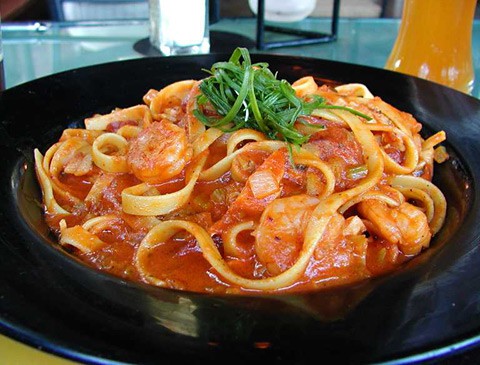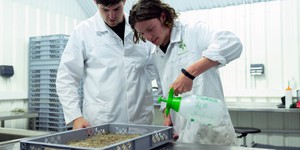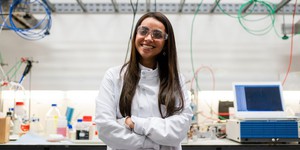Abstract
A plate of spaghetti, meatballs, and marinara sauce is a delicious and comforting meal. It's also an inexpensive meal, because it only costs about $12 to feed a family of four. And it's easy to make when you're on the go and need to eat a quick, but healthy dinner. Just boil a big pot of water, throw in your favorite pasta, cook for 11 minutes, drain, and top with meatballs and warm marinara sauce. Quick and cheap! But sometimes it feels like forever when you are waiting for water to boil, right? What if you really didn't need a big pot of water, which the pasta packages usually suggest? What if you could boil pasta in 50 percent less water? You might save water (a natural resource), energy (because it takes less fuel to boil less water), and time. Try this science fair project to find out if you can save natural resources and get a great meal. It could be a win-win situation!Summary
Michelle Maranowski, PhD, Science Buddies

Objective
To investigate the minimum amount and temperature of the water that is required to prepare pasta.
Introduction
Camping is a fun and invigorating activity and spending time in nature is relaxing. What is not relaxing is cooking meals over a campfire after a long hike around the campground. Most campers just want a hot and filling meal that cooks quickly. What about pasta? But no one wants to wait around for 20 minutes while the water comes to a boil. What can be done to shorten the time-consuming task of preparing to make pasta?
Before we talk about how to make pasta, let's learn more about the history of pasta and what happens when you cook it. Pasta is a product that is made by adding water to wheat flour to make a clay-like mass. It is then formed into shapes (like spaghetti strands) and then boiled in water. The texture and neutral flavor of pasta makes it a good partner for many different types of recipes and sauces.
The art of making pasta was developed in China, around 200 BCE (Before the Common Era). In the year 544 CE (Common Era), a treatise called Important Arts for the People's Welfare devoted a chapter to dough products. This document included different shapes of wheat noodles and different ways to make wheat noodles. Documents from 9th century Syria show that noodles were made from semolina dough, which is explained in just a minute. You might have heard the story that Marco Polo brought pasta from China into Europe in the 14th century, which is not true. Noodles were already present in 11th century Paris, France and in 12th century Sicily, Italy. Once pasta was introduced to Italy, the art of pasta making started to evolve. Pasta makers formed guilds (clubs) and made fresh pasta from soft wheat flour, and dried pastas from durum semolina flour, which is one of the three major types of wheat; the other two being hard wheat and soft wheat. Durum semolina flour has the highest content of gluten, which is the protein that makes bread elastic and chewy.
The goal when making pasta is to change dry flour into a mass that can be shaped into several forms, and is strong enough to stay intact when cooked. To make pasta, start by combining water and flour and then kneading the mass of dough. Once the dough has been kneaded, it is allowed to rest so that the flour particles absorb as much water as possible. The dough is then rolled out and folded repeatedly, and then cut or formed into the desired shape. Uncooked pasta consists of starch granules embedded in a structure of gluten proteins. When the pasta is cooked, the starch granules at the surface absorb the water and swell. Some of the starch is dissolved into the water, which you sometimes see foaming at the top of the water as you boil the pasta. With pasta that is cooked al dente, the water has penetrated into the center of the noodle, but the starch in the center has not absorbed a lot of water. The result is pasta that is fully cooked, but not overly soft. Al dente means "to the tooth."
Now back to making a quick and delicious meal after a long hike at the campground. Most pasta boxes recommend that you cook pasta in 4–6 quarts (qt.) of boiling water. But can hungry and tired campers wait for 6 quarts of water to boil? What would happen if you tried to cook pasta in 2 qts. of boiling water, or even in just 1 qt. of boiling water? Does the water have to boil before you put in the pasta? If everyone across the world used less water and didn't have to boil the water for pasta, that could certainly save a lot of energy! In this cooking and food science fair project, you will find the answers to these questions. Make sure you've got your marinara sauce, meatballs, and parmesan cheese on hand so that you can enjoy a nice dinner afterwards!
 Image Credit: Pdphoto.org / Public domain
Image Credit: Pdphoto.org / Public domain
Figure 1. A plate of delicious pasta with shrimp sauce. (Courtesy of PDPhoto.org, 2001.)
Terms and Concepts
- Flour
- Gluten
- Protein
- Elastic
- Knead
- Particle
- Starch
- Rolling boil
- Control
- Average, in math
Questions
- What is flour and out of what is it made?
- What does kneading do to the flour and water mixture? Is kneading necessary?
- What kinds of pastas did the ancient Chinese make?
- How many different kinds of pastas and pasta shapes are available today?
Bibliography
- McGee, H. On Food and Cooking: The Science and Lore of the Kitchen. New York: Scribner, 2004. pp. 571–579.
- Wikipedia Contributors. (2009, June 28). Spaghetti. Wikipedia: The Free Encyclopedia. Retrieved July 2, 2009.
- Wikipedia Contributors. (2009, July 1). List of Pasta. Wikipedia: The Free Encyclopedia. Retrieved July 2, 2009.
For help creating graphs, try this website:
- National Center for Education Statistics. (n.d.). Create a Graph. Retrieved June 2, 2009.
Materials and Equipment
- Pot, 6-quart (qt.) or larger, with lid (1)
- Liquid measuring cup
- Spaghetti, 1-pound (lb.) package (12 packages)
- Cooking spoon (1)
- Colander, large (1)
- Oven mitts
- Adult volunteer
- Food storage baggies, 1-gallon (gal.) size (9)
- Timer
- Lab notebook
- Graph paper
Experimental Procedure
Testing
- Place the pot on the stovetop. Read the instructions on the box of spaghetti and fill the pot with the recommended amount of water. Most boxes of spaghetti call for 4–6 qts. of water. Use the measuring cup to measure the amount shown on the pasta package. Cover the pot with the lid and set the burner to medium.
-
Cook the box of spaghetti as directed on the package. Time how long it takes to bring the pot of water to a rolling boil. Record this time, along with the amount of water in the pot, and that you are bringing the water to a rolling boil, in your lab notebook in a data table like the one shown below. Place the spaghetti in the pot and set the timer to the recommended cooking time for al dente spaghetti. This is usually the lesser time on the package.
Starting With Boiling Water or Cool Water Trial Pasta in Water at Beginning?
(Yes or No)Amount of Water Time Until Water is Boiling Time for Pasta to Cook and Reach Al Dente Stage Total Time to Prepare Pasta to Al Dente Boiling 1 No 4 qts. 2 3 Boiling 1 No 2 qts. 2 3 Cool 1 Yes 2 qts. 2 3 Cool 1 Yes 1 qt. 2 3 - Stir the pot a few times with the spoon during cooking so that the spaghetti strands don't stick together. Once the cooking time has elapsed, place the colander in the sink and drain the spaghetti. Ask an adult to help you drain the spaghetti because the pot will be heavy and very hot. Be sure to use the oven mitts.
- Once the pasta has cooled off for a couple of minutes, you and your volunteer should take a couple of bites of the spaghetti. Note how the spaghetti strands feel as you each bite into them in you lab notebook. Store the spaghetti in a baggie. Label the baggie with the cooking information and place it in the refrigerator. You will use this spaghetti as a control to compare doneness with subsequent batches.
-
Rinse out the pot with cold water and place it back onto the stovetop. Fill the pot with 2 qts. of water and put on the lid. Turn on the burner to medium.
- Time how long it takes to boil the water. Record this time in your lab notebook.
- Once the water comes to a rolling boil, place 1 lb. of spaghetti in the pot. Set the timer for 5 minutes. Ask your volunteer to keep track of time while you stir the spaghetti.
- After 5 minutes, remove 2–3 strands of spaghetti and allow them to cool a bit. Then both you and your volunteer should taste the spaghetti. Is it cooked through? Does it have the same feel as the spaghetti from step 1? If not, then allow the spaghetti to cook for another 2 minutes and repeat the taste test.
- Keep tasting the spaghetti after every 1 minute until the pasta is al dente. Compare this spaghetti with the spaghetti from step 4 to help you determine doneness. Record the final cook time in your lab notebook.
- When the spaghetti is al dente, turn off the burner and drain the spaghetti in the colander. Store the pasta in a baggie and label it with the cooking information. Keep the pasta in the refrigerator.
-
Rinse out the pot with cold water and place it back onto the stovetop. Fill the pot with 2 qts. of water and this time, also place 1 lb. of spaghetti into the pot. Do not put the lid on the pot. Turn on the burner to medium.
- Clear the timer and time how long it takes for the water to boil. Does the water ever come to a rolling boil? Record this time in your lab notebook.
- While you performing step 6a, you should, at the same time, stir the pasta with the spoon so that the pasta doesn't stick together. Start testing the pasta 3 minutes after it has all completely submerged in the water. As in step 5, take a few strands out of the water and you and your volunteer should bite into them. If they are al dente, then turn off the burner and drain the pasta in the colander. If the pasta is not done and al dente, then continue cooking and testing every minute. Compare this spaghetti with the spaghetti from step 4 to help you determine doneness. Record the final cook time in your lab notebook.
- When the spaghetti is al dente, turn off the burner and drain the spaghetti in the colander. Store the pasta in a baggie and label it with the test conditions. Keep the pasta in the refrigerator.
- Repeat step 6 using 1 qt. of water. Record the time to boiling and the al dente cook time in your lab notebook.
- Repeat steps 1–7 two more times, using fresh materials, so that you have a total of three trials for each cooking method. This ensures that your results are accurate and repeatable.
Analyzing the Data
- Plot the total time it took to cook the spaghetti for the different cooking conditions. Average the times of the three trials for each condition in the table above. Record the data in a table, like the one shown below. You can do the plots by hand, or if you need more information on the different kinds of plots or would like to make the plots online, try the following website: Create a Graph. Label the x-axis Cooking Condition and the y-axis Total Time to Al Dente Spaghetti. Which condition produces the fastest total preparation time? Is it faster to boil water first and then put in the spaghetti, or is faster to put in the spaghetti right away? Do you need 4–6 qts. of water, or does it cook just as quickly in less? At the end of the project, gather all of your spaghetti, warm it up, and enjoy with spaghetti sauce and meatballs!
| Starting With Boiling Water or Cool Water | Spaghetti in Water at Beginning? (Yes or No) | Amount of Water | Average Time Until Water is Boiling | Average Time for Spaghetti to Reach Al Dente Stage | Average Total Time to Prepare Al Dente Spaghetti |
| Boiling | |||||
| Boiling | |||||
| Cool | |||||
| Cool |
Ask an Expert
Global Connections
The United Nations Sustainable Development Goals (UNSDGs) are a blueprint to achieve a better and more sustainable future for all.
Variations
- Repeat this cooking and food science fair project using whole-wheat spaghetti.
- Repeat this cooking and food science fair project using different shapes of pasta. Determine the best way to cook each shape.
- Calculate the savings in energy, if any, using the method of cooking pasta that you developed above.
- How much water does the pasta absorb? Weigh the pasta on a scale prior to placing it in the water. Once you have cooked the pasta until it is done, dry of the water and reweigh it. Is there a difference in weight?
- Devise a way to determine how firm or al dente the pasta is after cooking.
Careers
If you like this project, you might enjoy exploring these related careers:









